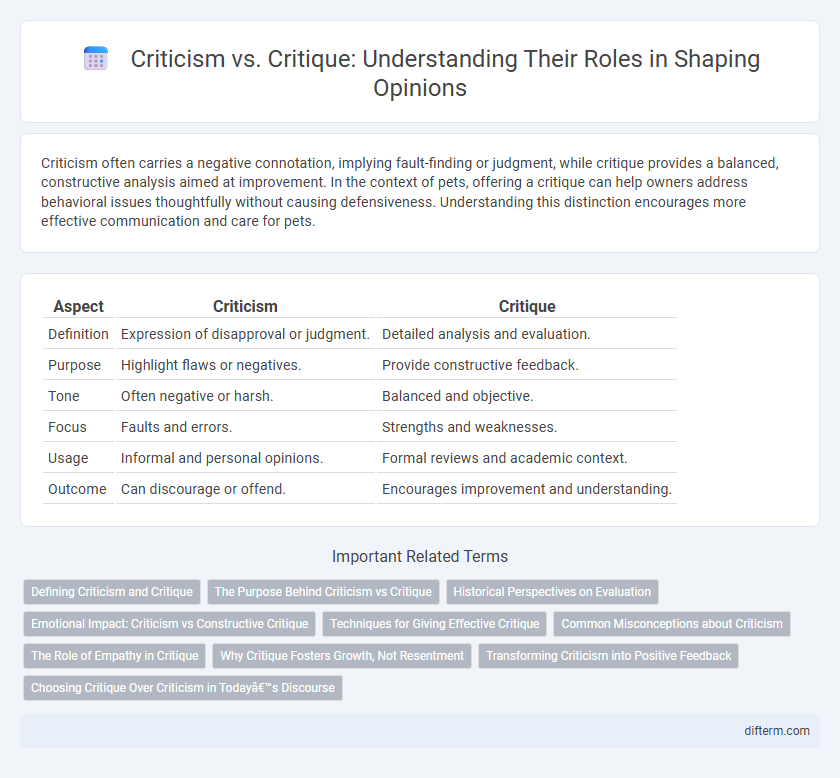Criticism often carries a negative connotation, implying fault-finding or judgment, while critique provides a balanced, constructive analysis aimed at improvement. In the context of pets, offering a critique can help owners address behavioral issues thoughtfully without causing defensiveness. Understanding this distinction encourages more effective communication and care for pets.
Table of Comparison
| Aspect | Criticism | Critique |
|---|---|---|
| Definition | Expression of disapproval or judgment. | Detailed analysis and evaluation. |
| Purpose | Highlight flaws or negatives. | Provide constructive feedback. |
| Tone | Often negative or harsh. | Balanced and objective. |
| Focus | Faults and errors. | Strengths and weaknesses. |
| Usage | Informal and personal opinions. | Formal reviews and academic context. |
| Outcome | Can discourage or offend. | Encourages improvement and understanding. |
Defining Criticism and Critique
Criticism involves evaluating and expressing disapproval or judgment about a subject, often highlighting faults or shortcomings. Critique, by contrast, is a balanced and detailed analysis that aims to understand and improve the subject through constructive feedback. The distinction lies in criticism being more negative and subjective, whereas critique offers objective, thoughtful appraisal fostering growth.
The Purpose Behind Criticism vs Critique
Criticism often aims to highlight faults or express disapproval, which can lead to defensive reactions and hinder constructive dialogue. Critique serves a purpose of thoughtful evaluation, offering specific feedback that fosters improvement and deeper understanding. Recognizing the intent behind each approach helps individuals engage more effectively in professional and personal growth.
Historical Perspectives on Evaluation
Criticism and critique have evolved differently through history, with criticism often rooted in subjective judgment and societal norms, while critique emphasizes analytical assessment grounded in philosophical traditions dating back to Aristotle. The Enlightenment period marked a shift, privileging critique as a method for systematic evaluation and intellectual progress rather than mere disapproval. Historic figures like Immanuel Kant defined critique as refined evaluation aimed at uncovering deeper understanding, contrasting with the everyday use of criticism as negative feedback.
Emotional Impact: Criticism vs Constructive Critique
Criticism often triggers defensive emotions and lowers motivation due to its focus on personal faults, whereas a constructive critique emphasizes specific behaviors and actionable improvements, fostering positive emotional responses and growth. Emotional impact plays a crucial role in how feedback is received, with constructive critiques promoting openness and self-reflection. This approach enhances learning environments and professional development by reducing anxiety and encouraging continuous improvement.
Techniques for Giving Effective Critique
Effective critique involves specific techniques such as focusing on observable behaviors rather than personal attributes to maintain objectivity and encourage growth. Utilizing clear, constructive language helps recipients understand actionable steps for improvement without feeling attacked. Emphasizing balance by acknowledging strengths alongside areas for development fosters receptiveness and motivation.
Common Misconceptions about Criticism
Criticism is frequently misunderstood as purely negative feedback, whereas critique involves constructive evaluation aimed at improvement. Many people conflate criticism with personal attacks, ignoring that effective critique targets ideas and performance, not individuals. Clarifying this distinction helps foster a more productive environment for growth and learning.
The Role of Empathy in Critique
Empathy plays a crucial role in effective critique by fostering understanding and respect for the creator's intentions and efforts, which distinguishes critique from mere criticism. Constructive critique focuses on providing insightful, balanced feedback that encourages growth, while criticism often centers on fault-finding without consideration of context or emotion. Cultivating empathy in critique promotes meaningful dialogue and positive development in creative and professional endeavors.
Why Critique Fosters Growth, Not Resentment
Critique fosters growth by providing constructive feedback aimed at improvement, whereas criticism often targets faults without offering solutions, leading to defensiveness. The clear, specific insights in critique encourage reflection and skill development, creating a positive learning environment. Emphasizing actionable suggestions helps individuals embrace change and build resilience rather than feeling attacked.
Transforming Criticism into Positive Feedback
Transforming criticism into positive feedback involves focusing on constructive elements that encourage growth and improvement rather than merely highlighting faults. Effective critique emphasizes specific behaviors or outcomes and suggests actionable solutions, fostering a culture of learning and motivation. This approach not only reduces defensive reactions but also enhances communication and collaboration in personal and professional settings.
Choosing Critique Over Criticism in Today’s Discourse
Choosing critique over criticism fosters constructive dialogue by emphasizing thoughtful analysis instead of mere fault-finding, enhancing personal growth and collaborative problem-solving. Critique encourages evidence-based feedback and solution-oriented discussions, promoting respect and openness in diverse conversations. Prioritizing critique in today's discourse helps mitigate polarization and supports intellectual humility and continuous learning.
criticism vs critique Infographic

 difterm.com
difterm.com